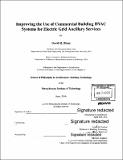Improving the use of commercial building HVAC systems for electric grid ancillary services
Author(s)
Blum, David H. (David Henry)
DownloadFull printable version (43.16Mb)
Other Contributors
Massachusetts Institute of Technology. Department of Architecture.
Advisor
Leslie K. Norford.
Terms of use
Metadata
Show full item recordAbstract
Increasing renewable and distributed electricity generation increases the requirement of grid-scale flexibility, often provided through ancillary services. Buildings can play a significant role in meeting this challenge by providing ancillary services with their HVAC systems. However, use of commercial HVAC systems in this way comes with significant challenges, which relate to interactions between the HVAC system and building operation, electricity markets, and electric grid operators. This thesis addresses these challenges through the use of dynamic modeling, model predictive control, and energy storage scaling techniques. First, a model of a representative VAV system is built using Modelica and simulated to characterize the system's performance while providing reserve and regulation ancillary services. It is found that reserves are provided most effectively when airflow is reduced through the terminal units, while regulation is provided most effectively when power-consuming equipment is directly controlled and has little effect on occupancy service. Next, a novel 24-hour HVAC MPC optimization problem is formulated and solved that separately accounts for a building's reserve and regulation revenue from electricity markets. Over a three-day period, it is found that ancillary service revenue can make up for 67% of HVAC energy costs when considering wholesale energy prices, and 18% when considering retail energy prices and market rules that disallow overlapping regulation and reserve capacity offerings. Second, an MPC control approach is used for the determination of opportunity costs associated with HVAC ancillary service provision, which are comparable to those of generators and could be bid into ancillary service markets. A method is developed to these costs and it is found that they can exceed $66/MWh if considering wholesale energy prices, and $93/MWh if considering retail electricity prices. Lastly, energy and power densities and costs for three thermal storage technologies available to commercial buildings are produced and compared to those of batteries. In addition, a method is developed to estimate the building HVAC reserve capacity within neighborhoods without the need for sophisticated energy simulations. In a case study involving 172 buildings, it is estimated that approximately 1100 kWh of peak hourly reserve capacity is available if thermostat setpoints are changed by 2°C.
Description
Thesis: Ph. D. in Building Technology, Massachusetts Institute of Technology, Department of Architecture, 2016. Cataloged from PDF version of thesis. Includes bibliographical references (pages 135-145).
Date issued
2016Department
Massachusetts Institute of Technology. Department of ArchitecturePublisher
Massachusetts Institute of Technology
Keywords
Architecture.